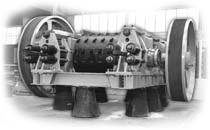|
|
Products and By-products of Coal
 For many years, coal was used only for heat and illumination. However the uses of coal have since multiplied.
Coal consists mostly of carbon, which is a necessary ingredient in the production of steel. To obtain the carbon in a pure state, coking is needed. Coking is simply "cooking" the coal. The coal is cooked in an iron vessel with a small vent on top. The substance drawn from the vessel, after the cooking is complete, is known as coke.
The hot gases which pass through the small vent during the coking process are known as "hydrocarbons." These gases are cooled and vented causing precipitation of small black beads known as tar.
For many years, coal was used only for heat and illumination. However the uses of coal have since multiplied.
Coal consists mostly of carbon, which is a necessary ingredient in the production of steel. To obtain the carbon in a pure state, coking is needed. Coking is simply "cooking" the coal. The coal is cooked in an iron vessel with a small vent on top. The substance drawn from the vessel, after the cooking is complete, is known as coke.
The hot gases which pass through the small vent during the coking process are known as "hydrocarbons." These gases are cooled and vented causing precipitation of small black beads known as tar.
The residue of the gases passes on and are forced to pass through a spray of sulphuric acid. The acid unites with a substance in the gas, and after this acid is treated to another process a salt precipitate, sulphate of ammonia, is formed.
The remainder of the gases is subjected to a process called "fractional distillation" and various light oils are precipitated.
A LIST OF MATERIALS THAT CAN BE EXTRACTED FROM ONE TON OF COAL:
|
Coke (1,300 to 1,500 pounds)
|
|
PRODUCT
|
USES
|
|
Lump Coke
|
metallurgical coke, copper smelting, iron smelting, lead smelting and iron and steel casting.
|
|
Calcium Carbide
|
acetylene chemicals
|
|
Water Gas
|
heating homes and industry chemical processing
|
|
Industrial
|
chemical processing, lime burning, beet sugar refining, manufacturing of mineral wool.
|
|
Screenings or Breeze
|
iron ore agglomeration, chemical processing, steam generation.
|
|
Coal Tar (8 to 10 gallons)
|
|
Tar Coal
|
carbolic acids, pharmaceuticals, cresole , lysol, photo developer, plastics, phenols, detergents, drugs, dyes, food preservatives, perfumes, rubber chemicals, weed killer.
|
|
Tar Bases
|
pyridine bases, antiseptics, disinfectants, paint thinner, pyridine, clothes water proofing, sulfa drugs, synthetic vitamins.
|
|
Napthaline
|
insecticides, fungicides, plastic dolls, explosives, moth balls, synthetic fibres.
|
|
Heavy Oil
|
dyes, embalming fluid, laxatives, wood preservatives.
|
|
Pitch
|
electrodes, insulating, paving, roofing, storage batteries, water proofing.
|
|
Light Oil
|
|
Benzene
|
synthetic fibres, nylon, aniline dyes, food preservatives, motor fuel, plastics, synthetic rubber, tanning fluids.
|
|
Toluene
|
antiseptics, fingernail polish, printing ink, saccharine, TNT explosives, aviation gas, detergents.
|
|
Xylene
|
motor fuel, gasoline solvents, herbicides.
|
|
Solvent Naptha
|
rubber solvent, electrical - insulation, linoleum, varnish.
|
|
Ammonia (5 to 6 pounds)
|
|
Ammonium Sulfate
|
fertilizers, chemicals.
|
|
Ammonia Liquor
|
fertilizers, explosives, household ammonia, refrigerant, nitric acid.
|
|
Diammonium Phosphate
|
fertilizer, fire retardant
|
|
Coal Gas (9,500 to 11,500 cubic feet)
|
|
Heating Purposes
|
Homes, industry
|
|
Sulphur
|
fungicides, insecticides, sulphuric acid.
|
|
Cyanogen
|
cotton finishing, dyes.
|
|








 For many years, coal was used only for heat and illumination. However the uses of coal have since multiplied.
Coal consists mostly of carbon, which is a necessary ingredient in the production of steel. To obtain the carbon in a pure state, coking is needed. Coking is simply "cooking" the coal. The coal is cooked in an iron vessel with a small vent on top. The substance drawn from the vessel, after the cooking is complete, is known as coke.
The hot gases which pass through the small vent during the coking process are known as "hydrocarbons." These gases are cooled and vented causing precipitation of small black beads known as tar.
For many years, coal was used only for heat and illumination. However the uses of coal have since multiplied.
Coal consists mostly of carbon, which is a necessary ingredient in the production of steel. To obtain the carbon in a pure state, coking is needed. Coking is simply "cooking" the coal. The coal is cooked in an iron vessel with a small vent on top. The substance drawn from the vessel, after the cooking is complete, is known as coke.
The hot gases which pass through the small vent during the coking process are known as "hydrocarbons." These gases are cooled and vented causing precipitation of small black beads known as tar.
